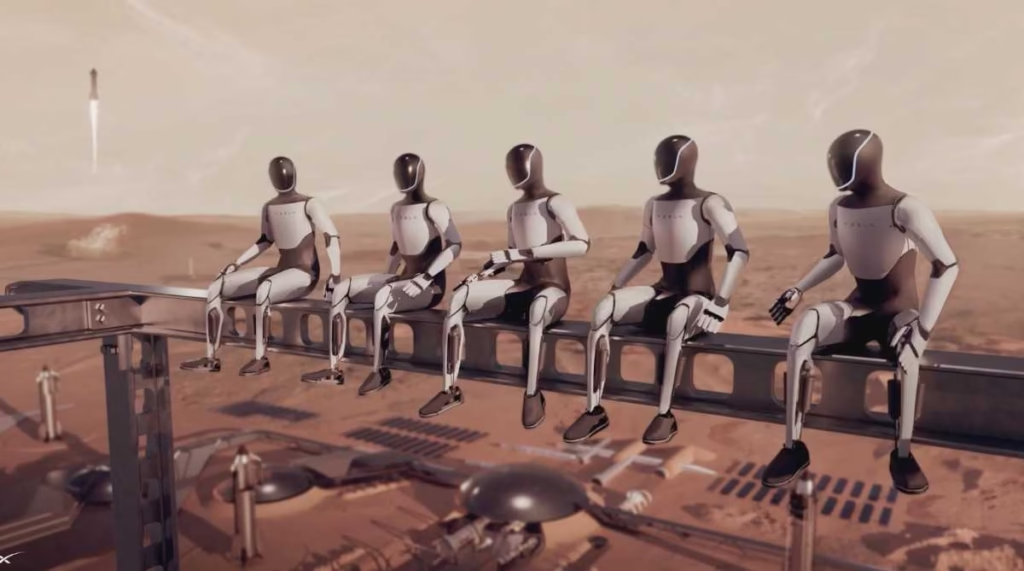Tesla’s Optimus On Mars Mission- discover how AI-driven robots like Tesla’s Optimus can help establish and maintain a Mars colony by building habitats, managing resources, and minimizing risk to human life.

Tesla’s Optimus On Mars Mission- An Introduction
As humanity advances toward interplanetary exploration, Mars has emerged as the next frontier. With missions from NASA, SpaceX, and other private players moving rapidly toward manned exploration of the Red Planet, the question of sustainable colonization becomes more urgent. One of the greatest challenges of building a colony on Mars is mitigating the high risks to human life. From toxic soil and radiation to extreme temperatures and isolation, Mars poses numerous hazards. Enter AI-driven humanoid robots like Tesla’s “Optimus,” designed to work in harsh environments with minimal oversight.
Tesla’s Optimus On Mars Mission: These robots could play a pivotal role in laying the foundation of a Martian colony before humans even arrive. Equipped with artificial intelligence, machine learning capabilities, and robust mechanical designs, AI robots like Optimus can perform repetitive, dangerous, and technically complex tasks. They are not only tools of labor but intelligent partners in the mission to expand human presence beyond Earth.
Tesla’s Optimus On Mars Mission: The Challenge of Mars Colonization
Mars is inhospitable to humans in every way. Its average temperature is around minus 60 degrees Celsius. The planet lacks a breathable atmosphere, has one-third of Earth’s gravity, and is bombarded by solar and cosmic radiation. Landing and living on Mars require protective habitats, energy sources, food production systems, and constant maintenance.
Transporting humans to Mars is expensive and high-risk. Thus, using AI-driven robots for pre-deployment work and long-term maintenance is both practical and essential. Their ability to operate continuously, adapt to unexpected challenges, and learn from data makes them ideal candidates for foundational work.
Tesla’s Optimus: The AI Humanoid Worker
Tesla’s humanoid robot, named Optimus, was first unveiled by Elon Musk in 2021. The project, part of Tesla’s broader AI strategy, is built on the same software and neural network foundation used in Tesla’s autonomous vehicles. Optimus is designed to handle dangerous, boring, or repetitive tasks — the very types of labor that would be needed in early Mars colonization efforts.
Key Features of Tesla Optimus Relevant to Mars Missions:
- AI Neural Network: Trained on real-world data from Tesla vehicles and robotics applications.
- Human-Like Dexterity: Able to handle tools, operate machinery, and manipulate objects with precision.
- Mobility: Capable of walking across uneven terrain, climbing stairs, and adjusting posture.
- Energy Efficiency: Optimus is powered by batteries and designed to operate continuously on minimal power, ideal for Mars where energy is limited.
- Autonomy and Remote Operation: Capable of autonomous decision-making and remote supervision from Earth or an orbital station.
Tesla’s Optimus On Mars Mission: Applications of AI Robots Like Optimus in Mars Colonization
1. Habitat Construction
One of the first steps in Mars colonization is building safe, pressurized habitats. This includes digging foundations, assembling modular living units, and sealing them against radiation and atmospheric leakage. Optimus and similar robots could:
- Assemble prefabricated habitat modules.
- Operate 3D printing equipment using Martian regolith.
- Lay wiring and install life support systems.
- Conduct quality checks using built-in sensors.
This reduces the need for human extravehicular activity, which is dangerous and resource-intensive.
2. Surface Exploration and Site Analysis
Before any infrastructure is built, the terrain must be mapped and evaluated. AI robots can carry out this task with sensors like LIDAR, thermal imaging, and spectrometers. They can:
- Scout and select optimal locations for bases.
- Identify natural shelters like lava tubes.
- Monitor soil composition and search for water ice.
- Map radiation levels and terrain hazards.
This allows mission planners to choose the safest and most resource-rich areas for development.
3. Solar Panel Deployment and Power Maintenance
Power is vital for any operation on Mars. AI robots could set up solar farms, clean solar panels of dust, and monitor electrical systems. Optimus could:
- Install large-scale solar arrays.
- Troubleshoot electrical circuits autonomously.
- Replace damaged wiring or components.
- Recharge itself from available energy sources.
By ensuring uninterrupted power supply, robots make sustained human presence viable.
4. Agricultural Automation
Food production is essential for long-term colonization. Robots can manage greenhouses, hydroponic systems, and bio-domes. Optimus units may:
- Plant and harvest crops using machine vision.
- Monitor water, light, and nutrient levels.
- Maintain environmental controls inside growth chambers.
- Carry samples to labs for analysis.
With machine learning, these robots can optimize crop yields even in unpredictable Martian conditions.
5. Repair and Maintenance Tasks
Every system on Mars — from air recyclers to communication antennas — requires regular maintenance. Failure can be fatal. Optimus robots are suited for:
- Diagnosing system faults using AI-driven predictive maintenance.
- Performing repairs using advanced toolkits.
- Carrying spare parts and conducting upgrades.
- Cleaning sensitive instruments and habitat interiors.
Their ability to operate in both routine and emergency scenarios makes them indispensable.
6. Radiation Monitoring and Shielding
Radiation is a constant threat on Mars due to the thin atmosphere. Robots can assist in:
- Installing protective shielding using Martian soil or hydrogen-based materials.
- Monitoring radiation levels in real time.
- Relocating equipment based on exposure data.
- Testing effectiveness of experimental shielding solutions.
This provides critical protection for both robots and future human settlers.
Tesla’s Optimus On Mars Mission: Minimizing Human Risk Through Robotic Autonomy
AI robots eliminate the need for humans to perform initial high-risk work. Before astronauts land, a fleet of Optimus units could already be building infrastructure, testing systems, and verifying environmental safety. This ensures that human crews arrive at a functional, tested habitat — significantly increasing their survival odds.
In emergency scenarios, robots can also assist in rescue operations, deliver supplies, or contain hazards like chemical leaks or mechanical failures without risking human life.
The Role of AI in Adaptive Decision-Making
Mars is unpredictable. AI’s strength lies in its ability to learn, adapt, and improve from experience. Optimus robots powered by advanced neural networks can:
- Learn from operational data over time.
- Communicate with each other and with mission control.
- Modify strategies based on environmental inputs.
- Handle tasks not explicitly programmed if trained on enough examples.
This flexibility is crucial when facing unknown challenges 225 million kilometers from Earth.
Tesla’s Optimus On Mars Mission: Interoperability with Other Robotic Systems
In addition to humanoid robots, other robotic systems like rovers, drones, and industrial bots will work in concert. Optimus can interface with:
- Autonomous rovers for logistics and transport.
- Construction robots for large-scale assembly.
- Flying drones for surveillance and inspection.
- Orbital satellites for high-level mission data.
This creates a robust robotic ecosystem capable of supporting an entire colony.
Long-Term Role in Human Colonization
As the colony grows, robots will continue to play a central role. They will help expand living quarters, mine resources, build roads, and even assist in scientific research. Over time, AI robots may evolve to operate with greater independence, becoming Mars’ primary labor force while humans focus on planning, leadership, and innovation.
Tesla’s Optimus, or future models inspired by it, could also serve psychological roles — offering companionship, assistance, and communication support to isolated astronauts.
Tesla’s Optimus On Mars Mission: Conclusion
Mars colonization is no longer a dream — it is a plan in motion. But the dream cannot be realized safely without intelligent, capable machines like Tesla’s Optimus. These AI-powered humanoid robots will be at the frontline, preparing the planet, maintaining operations, and ensuring that when humanity arrives, the foundation has already been laid.
Tesla’s Optimus On Mars Mission: By reducing the need for humans to perform life-threatening tasks, robots not only make Mars colonization safer but also more sustainable. With continued advancements in AI and robotics, the vision of a thriving, self-sufficient Mars colony grows more attainable each day.
News Source:-
https://x.com/SawyerMerritt/status/1928198540183880073?t=A2JN-wyWSVkIUjYfbBs82g&s=19
Tesla’s Optimus On Mars Mission FAQs: How Tesla’s Optimus Robots Could Help Colonize Mars
Q1: What is Tesla’s Optimus robot?
A: Tesla’s Optimus is a humanoid robot developed by Tesla Inc., designed to perform tasks that are dangerous, repetitive, or boring for humans. It uses the same AI technology as Tesla’s autonomous vehicles and is capable of walking, handling tools, and interacting with its environment.
Q2: Why are robots like Optimus important for Mars missions?
A: Mars has extreme conditions that are unsafe for humans. Robots like Optimus can prepare the environment, build shelters, set up power systems, and maintain equipment — all before humans arrive — reducing risk and ensuring mission safety.
Q3: What kind of tasks can Optimus perform on Mars?
A: Optimus can build habitat modules, install solar panels, grow food in greenhouses, repair mechanical systems, explore terrain, monitor radiation, and assist in emergencies — all without human intervention.
Q4: How will Optimus robots survive Mars’ harsh environment?
A: Optimus can be equipped with heat-resistant materials, dust protection, and specialized programming to function in Mars’ cold temperatures, low gravity, and dusty atmosphere. It can also operate within pressurized facilities or modified suits for external work.
Q5: Can Optimus be remotely controlled from Earth?
A: Yes, Optimus can be remotely monitored and directed from Earth or from an orbiting Mars station. However, due to communication delays, it is primarily designed to operate autonomously using artificial intelligence.
Q6: Will robots replace astronauts in space missions?
A: No. Robots are meant to support and protect astronauts by performing high-risk tasks. They help reduce human exposure to danger and make missions more efficient, but humans will still be central to leadership, science, and decision-making.
Q7: How does Optimus interact with other machines on Mars?
A: Optimus can work in coordination with rovers, drones, construction bots, and other automated systems. Through networked communication and shared AI protocols, these machines can collaborate on complex tasks like building infrastructure.
Q8: What powers the Optimus robot on Mars?
A: Optimus is powered by rechargeable batteries. On Mars, these would be charged using solar energy or nuclear power sources integrated into the colony’s power system.
Q9: Is Tesla the only company developing humanoid robots for space?
A: No, other companies and agencies, including NASA and Boston Dynamics, are also developing robotic systems for space exploration. However, Tesla’s Optimus is one of the most promising due to its integration of advanced AI and real-world engineering.
Q10: When could Optimus be deployed to Mars?
A: While no official date is set, Optimus or similar robots could be sent on early Mars missions within the next decade, especially if SpaceX or other agencies pursue crewed Mars missions in the 2030s.
